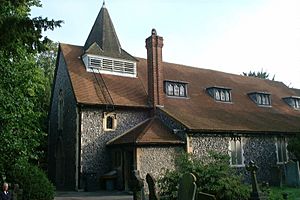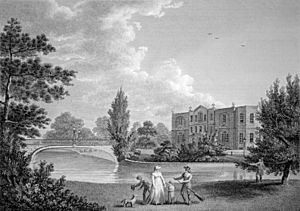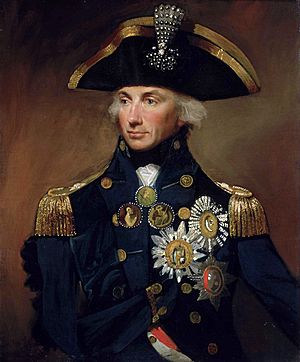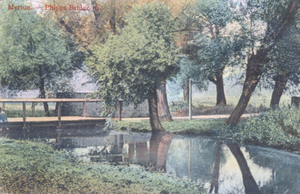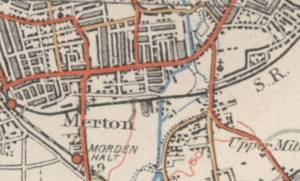Merton, London (parish) facts for kids
| Merton | |
| Geography | |
| Status | Civil parish (rural until 1907, then urban) |
| 1881 area | 1,765 acres |
| 1921 area | 1,762 acres |
| 1951 area | 1,762 acres |
| History | |
| Origin | Ancient parish |
| Abolished | 1 April 1965 |
| Succeeded by | London Borough of Merton |
Quick facts for kids Demography |
|
|---|---|
| 1881 population - 1881 density |
2,480 1.4/acre |
| 1921 population - 1921 density |
16,177 9.2/acre |
| 1951 population - 1951 density |
39,313 22.3/acre |
| Politics | |
| Governance | Merton Parish Council (1894—1907) |
Merton is a very old area that was once a parish in Surrey, England. Since 1965, it has been part of Greater London. Today, it is known as Merton Priory.
Merton is surrounded by other areas. To the north is Wimbledon. To the east is Mitcham. To the south are Morden, Cheam, and Cuddington. To the west is (New) Malden. In 1871, the area was about 1,765 acres (2.7 square miles).
The heart of the parish has always been the 12th-century St Mary's Church in Merton Park. Over time, the area changed. In 1907, the local government part of the parish became the Merton Urban District. This district grew and became the London Borough of Merton in 1965.
Contents
Understanding the Name Merton
Merton Park is a common name for a neighborhood in the area. However, the name "Merton" itself is not often used by people living or working there to describe a specific district. Instead, people prefer names like "Park" and "Wood" estates, which came from railway stations. These include Raynes Park, Colliers Wood, part of Motspur Park, and South Wimbledon.
The larger area, the London Borough of Merton, gets its name from Merton Priory.
Merton is also one of the places where the English surname Merton comes from. It is also the origin of Merton College, Oxford. This famous college had its early beginnings and owned a lot of land here.
Merton's Past: A Journey Through Time
Early Beginnings
The village of Merton started as a long settlement. It stretched west from Stane Street, a Roman road that connected London to Chichester. This road locally ran from Colliers Wood High Street to London Road, Morden.
The name "Merton" is very old, dating back to at least the 7th century. Its meaning can be "Farmstead by the mere (small lake)" or "Maera's homestead."
Merton is mentioned in the Domesday Book of 1086 as Meretone. This book showed it was the largest community in the area at that time. It was owned by William the Conqueror. Its resources included:
- 20 hides of land (a hide was a measure of land).
- 1 church.
- 2 mills that made £3 per year.
- 21 ploughs (areas of land for farming).
- 12 acres of meadow.
- woodland that could support 80 hogs.
It also brought in £43 a year for its owners. An extra £1 18s 2d came from 16 houses in Southwark.
Merton Priory: A Place of Learning
The priory, also called the Priory of St Mary of Merton, was founded in 1114 by Gilbert Norman. It was located near where a Sainsbury's store is today. In 1117, it became an Augustinian monastery. It became very famous for its learning and studies.
It is believed that Walter de Merton, who founded Merton College, Oxford, was born here. In 1235, King Henry III met with his barons here. They discussed and agreed upon the Statute of Merton, which was an important set of laws. The priory also educated Saint Thomas Becket. It is also thought that Nicholas Breakspear, the only English Pope, studied here.
The priory, like most others, closed down in 1538 during the reign of Henry VIII. This was part of the Dissolution of the Monasteries. The priory owned a lot of land in the area. Its buildings were taken apart, and the materials were used elsewhere.
In 1496, a hospice (a place for travelers) was built across from the Sainsbury's site. An inn was built there in 1594 and sold beer until 2004, when it closed. The current building was built in 1931 and is a protected local building.
17th and 18th Centuries: Industry and Estates
| 1801 | 813 |
|---|---|
| 1811 | 905 |
| 1821 | 1,177 |
| 1831 | 1,447 |
| 1841 | 1,914 |
| 1851 | 1,870 |
| 1861 | 1,822 |
| 1871 | 2,139 |
| 1881 | 2,480 |
| 1891 | 3,360 |
| 1901 | 4,510 |
| 1911 | 12,938 |
| 1921 | 16,177 |
| 1931 | 28,609 |
| 1941 | war # |
| 1951 | 39,313 |
| # no census was held due to war | |
| source: United Kingdom census | |
The River Wandle flows north towards Wandsworth. For centuries, it powered watermills and provided water for industries. In the 1660s, a silk mill operated in Merton Abbey. The Jacob family also had a fabric bleaching ground nearby. This process needed a lot of water. The name "Jacob's Green" was still used in maps two hundred years later.
Textile production became the main industry in the area in the 18th century. Calico printing started in the 1720s.
In 1764, a merchant named Richard Hotham bought a property called Moat House Farm. It was south of Merton High Street. He improved the house and renamed it "Merton Place". He later sold it to Charles Greaves, who was a partner in a local calico factory.
Hotham then built another house called "Hotham House" (later "Merton Grove"). It was located north-west of the Kingston Road and Morden Road junction. He owned it until he died in 1799.
19th Century: Growth and Nelson's Home
At the start of the 19th century, Merton was mostly a rural farming area. However, its population grew quickly at different times. It nearly doubled from 1811 to 1841. Then it stayed about the same for 40 years. It almost tripled in the 10 years leading up to 1911. Finally, it more than doubled from 1921 to 1951, becoming a mostly urban area.
In 1803, the Surrey Iron Railway opened. This railway connected Wandsworth and Croydon. It followed the Wandle valley and passed through Merton and Mitcham. Even though it was horse-drawn, it helped industries along the river send their goods to wharves on the Thames. From Merton High Street, the railway ran along Christchurch Road.
In September 1802, Vice-Admiral Horatio Nelson bought Merton Place. He bought it from Charles Greaves' widow for £9,000. The house was built around the early 1700s and was in bad condition. Nelson bought more land, and his property covered most of the area west of the Wandle.
Nelson lived at Merton Place with his mistress Emma Hamilton and her husband Sir William Hamilton. Emma decorated the house to honor Nelson. She also planned gardens and filled the grounds with animals. They both called the property "the farm." Their daughter Horatia often stayed with them there.
Nelson lived here for almost four years when he was not at sea. He died at the Battle of Trafalgar in October 1805. Emma inherited Merton Place, but she struggled to keep up with the costs. She fell into debt, and the estate was sold in 1809.
The house was pulled down in 1821. The land was sold off in smaller pieces over the next few years. The area south of the High Street became small houses called Nelson's Fields. The land north of the High Street remained undeveloped until the end of the century. Local street names like Nelson Road, Trafalgar Road, and Hamilton Road remember this history.
The Surrey Iron Railway closed in 1846 because of competition from newer, steam-powered railways. Part of its route was later used by the Wimbledon and Croydon Railway, which opened in 1855.
In the 1860s, a flour mill was at the junction of Bygrove Road and Wandle Bank. There was also a copper rolling mill on Merton High Street. This mill was owned by James Shears and Sons. Further south, the Merton Abbey Mills complex grew on both sides of the river.
In 1868, the Tooting, Merton and Wimbledon Railway opened a new line. It connected Merton Park station (now Merton Park tram stop) to Tooting Junction station (now Tooting station). Merton Abbey station was built to serve the industries there.
Merton continued its long history with textile printing. The Arts and Crafts designer William Morris opened a workshop at Merton Abbey Mills in 1881. Nearby, Edmund Littler's firm was known for its high-quality printing. By the 1890s, they sent all their products to Liberty & Co. in Regent Street. Liberty & Co. later took over the production at Merton.
More industries developed along the Wandle. Homes also started to be built in the late Victorian period. This happened north of the High Street and along Kingston Road and in Merton Park. In 1894, a new Local Government Act was passed. Merton was still considered rural enough to be part of the Croydon Rural District.
20th Century: Modern Merton
In the early 1900s, Merton changed a lot. Its fields were developed into new areas. The population grew so much that Merton was removed from the Croydon Rural District. The Merton Urban District was created in 1907. Between 1901 and 1921, Merton's population almost quadrupled. It went from 4,510 to 16,177 people.
In 1913, Morden parish also joined the Merton Urban District. This formed the Merton and Morden Urban District.
Hotham's Merton Grove House was pulled down by 1913 to make way for new housing. The Grove Tavern across Kingston Road still remembers the name.
Growth was helped by the arrival of trams on Merton High Street in the early 1900s. A new bus garage opened in 1913. Tram services and the extension of the Underground Electric Railways Company of London's City & South London Railway to Morden in 1926 reduced the need for passenger trains on the Merton Abbey line. These services ended in 1929. Goods trains continued until 1975, when the line closed.
Liberty & Co. continued to operate the Merton Abbey Mills until 1972. From the 1930s, large industrial areas were built on the southern part of the former Merton Place estate.
Part of the old railway route was used to build Merantun Way (A24) in the early 1990s. This road was built to ease traffic on Merton High Street.
During the 20th century, the Wandle River became less important for industries. In the 1980s and 1990s, most of the industries at Merton Abbey closed or moved. The Sainsbury's Savacentre now occupies part of the site. The old Mill buildings were restored and became a popular heritage and craft center. The Colour House, where Liberty dyed fabric, became a theater in 1995.
When automatic telephone exchanges were introduced in the UK, the code for Merton and South Wimbledon was "542." This was linked to the word "LIBerty," from the Liberty fabric works. Letter codes were stopped in the late 1960s.
Merton's Geography
Until the 20th century, most of Merton was rural. The main places where people lived and worked were Merton Park and along Merton High Street. This area was between modern South Wimbledon and Colliers Wood.
Other modern areas that are part of the original parish include:
- Wimbledon Chase
- Southern Raynes Park
- Motspur Park/West Barnes
Merton's Heritage: Remembering the Past
A small memorial stands where Merton Place used to be. Other things that remind us of Nelson's connection to Merton include:
- The former Nelson Hospital on Kingston Road, now the Nelson Health Centre.
- The Emma Hamilton public house in Wimbledon Chase, which closed in 2011.
The Nelson Trading Estate and streets like Hamilton, Hardy, Nelson, Victory, and Trafalgar Roads are all built on land that was once part of Nelson's Merton Place estate.
Nelson's and Emma's special seat (pew) is still in St Mary the Virgin church. On the wall of the church, you can see the funerary hatchments (coat of arms displays) of both Nelson and Sir William Hamilton. Outside the church, on Church Path, are "Nelson's Steps." These steps were supposedly used by Nelson to get on his horse. This area is now a small conservation area.
Building work in the Merton Abbey area has uncovered parts of Merton Priory. These remains have been protected and saved where possible. More archaeological digs are planned for the future.
Merton's Namesake
The surname Merton mostly comes from other places, not this Merton in London. The London Borough of Merton is one of 24 London boroughs named after an old medieval parish or city.
Famous People Connected to Merton
Many notable people have connections to the parish of Merton:
- Elizabeth Alexander, a geologist and physicist.
- Raymond Austin, a director, writer, and actor.
- Thomas Becket, a saint who was educated at Merton Abbey.
- Nicholas Breakspear (Pope Adrian IV), the only English Pope, educated at Merton Abbey.
- Elisabeth Dermot Walsh, an English actress.
- David Garrick, a famous actor and dramatist, lived at Church House.
- James Pierrepont Greaves, an educational reformer, was born here.
- Emma Hamilton, the mistress of Admiral Nelson.
- William Hamilton, a diplomat and Emma Hamilton's husband.
- Richard Hotham, who developed Bognor Regis.
- John Innes, who developed Merton Park.
- Lauderdale Maitland, an actor.
- Walter de Merton, a Lord Chancellor and Bishop, educated at Merton Abbey. He founded Merton College, Oxford.
- William Morris, a famous artist and writer.
- Horatio Nelson, 1st Viscount Nelson, the famous admiral.
- Richard Brinsley Sheridan, a dramatist and politician, lived at Church House.
- Isaac Smith, who sailed with Captain James Cook on the Endeavour, lived at Merton Abbey.
- Rose Emma Lamartine Yates, a social campaigner and suffragette, lived at Dorset Hall.


